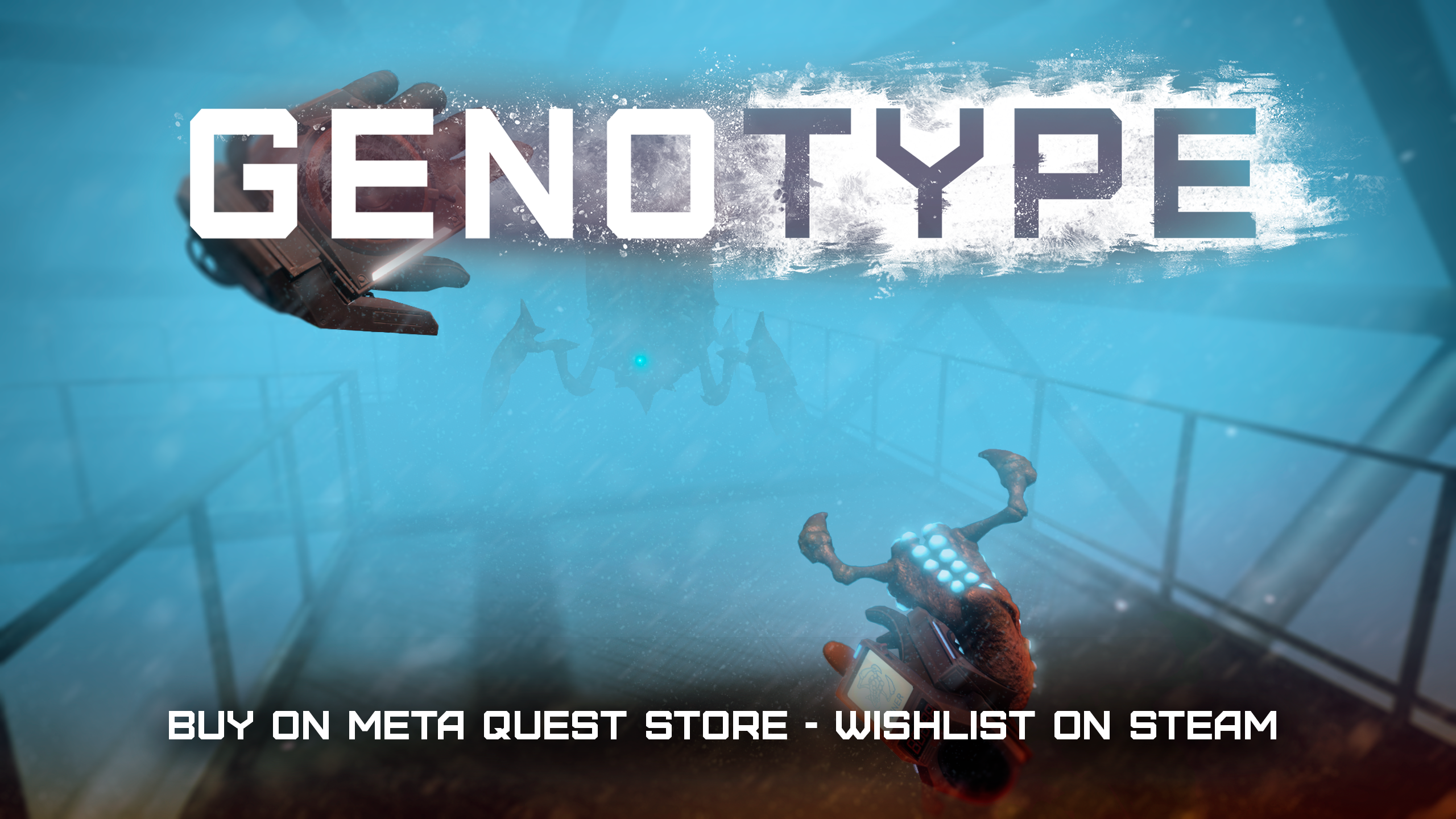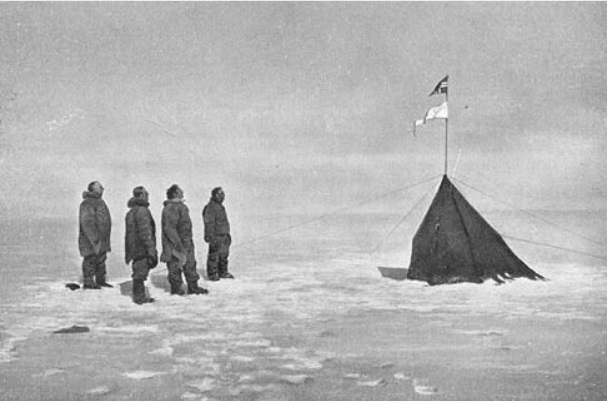“To my widow,”
Writing the backstory for Genotype
Genotype is a contender for IndieDB IOTY -thank you for your vote!

It's possible to wishlist Genotype on Steam. Go to Steam! or Buy Genotype in the Meta Quest store
In Genotype, the main character enters a vast Antarctican research station. Writing the story for the game, Morten Brunbjerg, our writer, took departure in the exploits of Sir Robert Falcon Scott, a British explorer-scientist during the “Heroic Age of Antarctic Exploration.” Scott led an expedition to reach the geographical South Pole in 1910-1912. He and his team perished on the return, freezing to death just a few miles from safety as a weeks-long blizzard raged outside their tent.
Genotype is not a game about Scott or Arctic exploration. Still, it’s been present in the mind of Morten Brunbjerg as he wrote the story:
“We began with the real story of Robert Falcon Scott's last adventure on the South Pole, and then we started making things up from there. Genotype has little to do with reality, but the tragic story of the Terra Nova Expedition inspires us. You could call it Genotype's background story. As the production proceeds, backstory sometimes becomes exceptionally important; other times, it fades into the background and anchors the story. At this moment in production, the backstory is just that - background. However, Robert Falcon Scott's story is thematically spot on, as Genotype deals with loneliness. I can't imagine anything more lonely than a tent at the South Pole.”
Though unsuccessful in some ways, Scott’s mission succeeded in others. The 12 scientists on the expedition crew made important discoveries in several fields. Scott’s ship, the Terra Nova, returned to England with 2100 plants, animals, and fossils, 400 previously undiscovered. The meteorological data provide baselines for current assessments of climate change.
The fictional backstory for Genotype begins after a search party finds Scott’s lost expedition.
In the tent, ice core samples of biological material are discovered and identified as unknown. A research station is built secretly, and the materials are studied and experimented on. Eventually, the science goes wrong, and the strange samples grow and evolve, ultimately taking over and destroying the base. Years later, Evely, our main character, enters the scene.
For your intellectual limbering, you’ll find an account of the actual events in the race to be first on the South Pole. Below. Enjoy! Or not…
To My Widow
“We shall stick it out to the end, but we are getting weaker, of course, and the end cannot be far. It seems a pity, but I do not think I can write more.”
This quote is the last entry in Sir Robert Falcon Scott’s 1912 diary, as he lay confined by terrible weather to his tent with two of his South Pole expedition members, slowly starving and freezing to death.
Two years prior, in June 1910, Sir Robert Falcon Scott of the British Empire set sail from Wales on the “Terra Nova expedition” to become the first human on the geographical South Pole. He’d been to the continent once before, on a 3-year exploration from 1901 to 1904. A decorated Royal Navy officer and a scientist, Scott’s plans to conquer Antarctica and plant Union Jack on the South Pole were well known.
By contrast, Norwegian explorer Roald Amundsen was planning a North Pole expedition when American rivals Peary and Cook each claimed to have reached the dot. In absolute secrecy, Amundsen diverted his plans to the South Pole instead, informing his crew of their new destination only when their ship was well on the high seas in June 1910.
Both teams arrived well in Antarctica and set up camp for the winter before starting their journeys into the hinterland. By now, Scott became aware that he competed with Amundsen. In October 1911, Amundsen set out on dogsleds and skis from The Bay of Whales. Scott left his camp in McMurdo Sound two weeks later, on November 1., with ponies, some dogs, and motorized vehicles.
When Scott reached the Pole, they had been underway for roughly three months, covering 862 miles (1,387 km). What they found was a tent. Within it, a stool and some equipment for Scott. On the seat was a note neatly placed upon it. In the immortal words of Nelson Muntz, the message read, “HA!HA!” In actuality, it was a greeting to Scott from Amundsen.

Roald Amundsen's tent, “Polheim,” greeted Robert Scott upon his arrival at the South Pole.
Photo: Wikipedia.
Amundsen’s crew and their expert handling of snow sleds had completed the journey in just under two months, arriving five weeks before Scott. It had by no means been easy. Death made several threatening appearances on the way, and the team (as planned) had eaten most of their 52 dogs. Roald Amundsen would, in 1926, also be the first verified visitor to the North Pole, flying over it in an airship.
In his journal, Scott records his arrival at the South Pole, realizing his defeat:
“The worst has happened [...] All the daydreams must go [...] Great God! This is an awful place.”
Disappointed, Scott’s five-man group began their return journey. Oates, Bowers, Scott, Wilson, and Evans never made it home. Evans died after a fall on February 17. Later, when horrible weather plagued the expedition, Owens, his ability to move gravely hindered by frostbite, walked out of the tent one evening saying only: “I am just going outside and may be some time.”
His noble suicide was a futile attempt to save the others, as the three remaining men remained unable to progress due to the weather:
−47 °F (−44 °C), snow, and gale-force winds. In the tent, just 11 miles south of their advanced supplies depot, Scott maintained his diary. In it, he wrote a letter to his wife initiated by the words:
“To my widow,”
Genotype is a contender for IndieDB GOTY -don't forget to vote!
The game
In Genotype, you explore an Antarctic research base overrun by monstrous beasts, wielding high-tech gloves that print living organisms you can use as weapons and survival tools.
- Print creatures and use them as weapons to fight off aggressive beasts.
- Transform into other beings to move through vents and use them as tools to clear environmental obstructions.
- Upgrade your creatures' DNA to enhance their capabilities, and customize your GRAID gloves to increase your survival chances.
- Enjoy high-fidelity graphics that take full advantage of the Meta Quest platforms' graphical potential.
- Immerse yourself in an emotional narrative with fully voice-acted characters.
- Dive into a world with truly alien sound design and atmospheric synth-scapes.
You play as Evely, an intern at an Antarctic weather station. During a routine expedition, Evely falls through the ice into the mysterious Snowdrop Initiative laboratories. Luckily, the facility's last human survivor, William, can guide her to save herself — and the entire planet.
The Studio
Bolverk Games is an award-winning indie studio based in Denmark focused on VR games and software. We were among the first to realize how VR gaming could be more than a novelty, and we are still at the forefront of a growing market, always exploring VR’s potential.
www.playgenotype.com
www.bolverkgames.com
BUY GENOTYPE ON META QUEST STORE
For quotes and comments, contact press@bolverkgames.com.
Sources:
Photo: Polheim. (2022, March 10). In Wikipedia.


